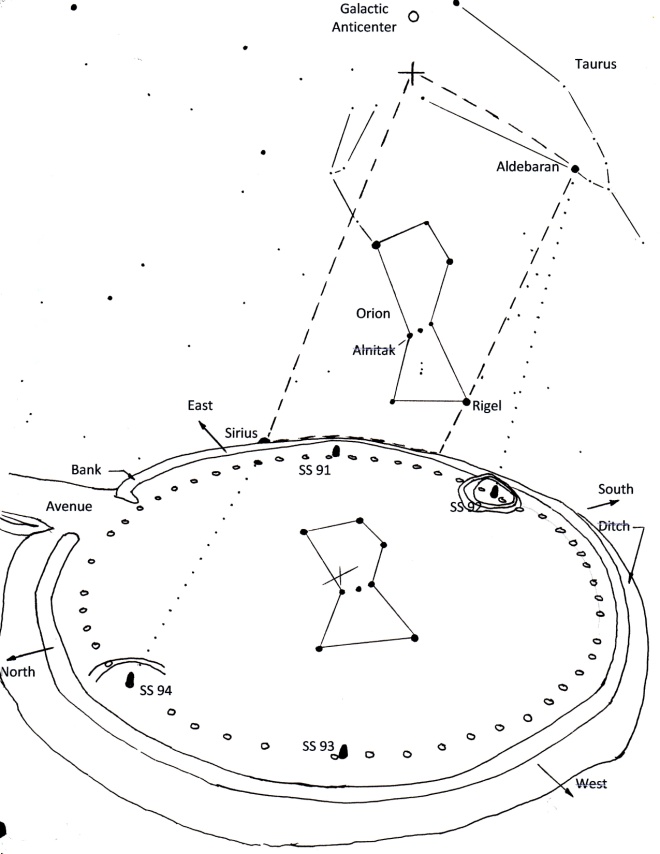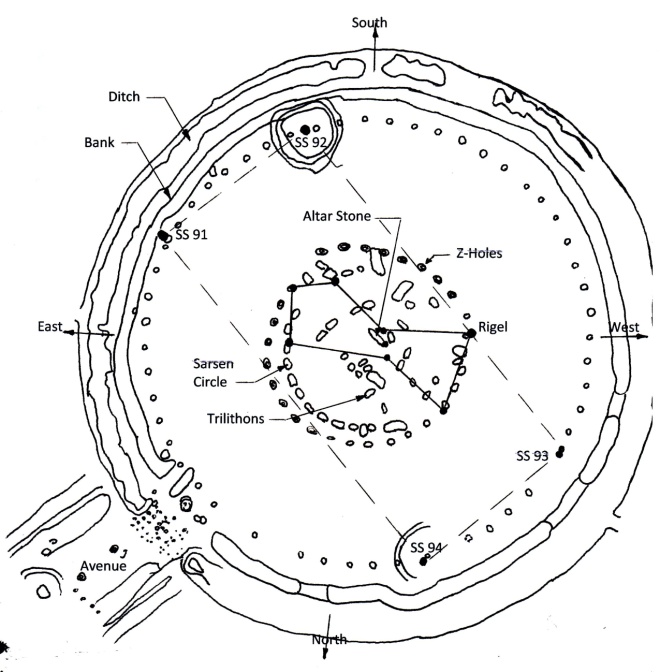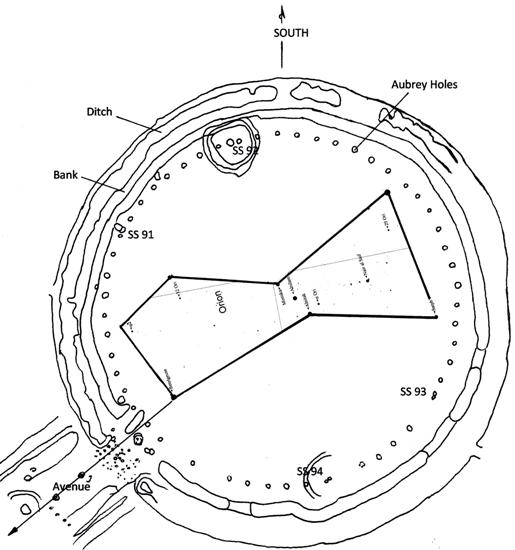Please welcome our Author of the Month for December, Paul Burley. Paul is the author of two books, Stonehenge: As Above, So Below and The Sacred Sphere: Exploring Sacred Concepts and Cosmic Consciousness through Universal. In this article he outlines his theory about the mystery of Stonehenge.
According to archaeologists we have no way for understanding the thoughts and intentions of prehistoric people because we have no written records prior to first use of cuneiform script in Sumeria dating to no earlier than about 2500 BC. Is this conclusion fact or fantasy?
In this article I show that the ancient culture of Neolithic Britain developed means for communicating tremendous amounts of information about themselves prior to the advent of writing. The way in which that information was, and continues to be, communicated from our distant past is through use of symbolism. Of course, written languages are nothing more than series of symbols (letters, words, sentences) representing sounds that are uniformly interpreted by cultures as representing specific ideas. For prehistoric people, pictographic symbols included such simple geometrical figures as the circle, square, dots, and so forth. As will be shown, those symbols were devices relaying vitally important information used by those people, and the symbols remain readily available to us for understanding the sacred, spiritual traditions of those cultures.
However, remnant artifacts and architecture of prehistoric cultures are filled with symbolism too. We might not be able to attach particular sounds to the symbols, but the meaning of the symbols can be deciphered – often quite readily – if we have the ability to recognize and understand the prehistoric use of graphical, spatial or geospatial symbolism. By that I mean use of spatial relationships between physical elements to express a concept, purpose or intention. A well known example of this is the basic architectural geometry of pyramids at Giza near Cairo, Egypt. In this paper I demonstrate prehistoric application of spatial symbolism exemplified in the architecture of the late Neolithic megalithic structure we know as Stonehenge, in the county of Wiltshire, England.
Purpose
Like everyone else I’ve been mystified by the array of circular ditch, bank and megalithic stones –residual architectural elements of Stonehenge, the most well known prehistoric structure in Europe. Why did people go to great lengths to construct such a grand and mysterious structure? Certainly its grand scale is related to its purpose and perhaps vital function serving the needs of the people. We may better understand Stonehenge’s original purpose and function by testing the assumption that each is directly related to the monument’s architecture. How are the purpose and function of Stonehenge indicated by its architecture?
Many theories attempt to explain the intent and use of the monument. Since the seventeenth century most interpretations of the various circles of stones, post holes, ditches and banks propose use of the monument to observe astronomical events such as solar risings and settings during solstices and equinoxes, lunar maximum and minimum standstills, and the path of Venus. However, other than a modest number of perceived alignments such as the monument’s center and Heel Stone oriented toward summer solstice sunrise, the archaeological community generally remains skeptical of such intent. Many of the theories do not address techniques necessary for observing the various roughly defined alignments often found to be approximate.
During late 2011 I began to analyze the configuration of megaliths within the context of previously documented cultural traditions including capabilities in astronomy ca. 2500 BC when the stones were installed, ca. 2500 BC. The analysis applied astronomical modeling software to identify potentially related cosmic events indicated for that time. Specifically, the study evaluated the potential for four particular stones – the Station Stones – to have contributed to an astronomical function of Stonehenge. The Station Stones are located near the inside edge of the monument’s circular ditch. Their locations form a quadrilateral which seems out of place given the generally circular nature of Stonehenge. Some of the monument’s stone alignment theories are associated with the Station Stones, but there is no certain means for testing those theories.
Analysis
Intent of the Station Stone quadrilateral
The Station Stone quadrilateral is illustrated in Figure 1. The stones are labeled SS91 through SS94, and represent the four corners of the quadrilateral. Azimuths (measured from true north) of the northern and southern long sides of the Station Stone quadrilateral are 139.43o and 139.23o, respectively. Analysis of the cosmic dome during late July and early August ca. 2500 BC reveals astronomical events that were readily observable in the southeastern night sky. Importantly, those events accord with cosmographies, mythologies and universal sacred understandings directly associated with ancient and indigenous people, including many Neolithic cultures. The stellar events were above the horizon, oriented toward azimuths within about 22.67o (the angle between Station diagonals) of the mean long side orientation (139.33o) of the Station Stone quadrilateral.
The analysis applied Starry NightTM Enthusiast, version 4.5 to view a model of the pre-dawn sky at Stonehenge during 2500 BC. On August 2, first glint of the sun occurred at about 3:53 AM and so we begin observing the night sky about 35 minutes earlier, when the sun is almost 7o below the horizon. At that time, at azimuth (α) 128.8o, Alnitak (the eastern of Orion’s three belt stars) was rising at an altitude (h) of 9.4o, while Aldebaran in the constellation Taurus was at α 142.9o, h 30.3o. Sirius, the ‘dog star’, was below the horizon. The closest star to the horizon in Orion was Saiph at α 128.4o, h 1.5o, certainly observable in a clear pre-dawn sky. At that moment the complex of stars in Orion could have been seen in their entirety minutes before the sun made its appearance at azimuth 52.0o. That was the morning of Saiph’s heliacal rising after summer solstice.

Figure 1: Locations of the four Station Stones (drawing by author based on North, J. (1997), fig.157)
Thirteen days later, on the morning of August 15, Sirius made its heliacal rising at α 126.5o, h 1.25o while the sun was about 6.25o below the horizon (Figure 2). At that moment, with Sirius barely visible over the horizon, Orion would have been seen above and to the right. Aldebaran was farther up and right (α 159.80, h 34.8o) as the Pleiades (α 175.50, h 41.2o) approached the meridian (Figure 2). On that morning the sun appeared at azimuth 56.0o.
To summarize, on the morning of August 2 Orion’s heliacal rising was accomplished with Saiph’s first appearance after summer solstice. On August 15, when Sirius made its heliacal rising, Orion’s three belt stars were located between azimuths of 142.0 and 144.2 degrees, and Aldebaran was at azimuth 159.80 At that moment, if we had been positioned at the center of Stonehenge, we would have seen between Station Stones 91 and 92 that portion of the cosmic dome between Sirius (east) and Aldebaran (west) at altitudes ranging from near the horizon (Sirius) to about 35o (Aldebaran).
We can now envision an area of the sky in the shape of a quadrilateral, with Sirius located at the lower left corner and Aldebaran at the upper right corner. Sirius and Aldebaran are two points in the night sky that define the size and orientation of a celestial quadrilateral.

Figure 2: View of southeast sky between SS 91 and SS 92 before sunrise, August 15, 2500 BC
Emplacement of Orion at Stonehenge Sub-phase 3ii
Having envisioned a near rectangular portion of the cosmic dome between Station Stones 91 and 92 as a planar feature framed by Sirius and Aldebaran at opposite corners, we can easily map each of the other star locations within the quadrilateral. With Sirius located at the bottom left corner and Aldebaran –appearing directly above Stone 92 as seen from the monument’s center – at the upper right corner, it is then a simple matter to conceptually rotate the rectangular area onto the surface of Earth (Figure 3).
Specifically, we symbolically emplace Aldebaran at Station 92 and Sirius at Station 94. After doing so we then plot the remaining stars onto the ground surface using the diagonal between Station 92 and Station 94 as the baseline for the survey. Pairing Aldebaran with Stone 92 is a decision easily made since the star is observed to be directly above that Station location. By default Sirius must be represented by Stone 94 because the stone’s location is the corner opposite of Stone 92.
Several surprising yet important findings are immediately apparent once the various stars of Orion are plotted accurately onto the plan of Stonehenge (Figure 4).
-
Three stars (Meissa, Rigel and Saiph) representing the head and two feet of the constellation plot onto the plan of Z-Holes (nos. 7, 18 and 22) east and west of the monument’s center.

Figure 3: Translocation of Orion to the ground surface at Stonehenge
-
Two additional stars (Betelgeuse and Bellatrix) representing Orion’s shoulders plot onto the ring of sarsens (nos. 5 and 9) east of the center.
-
The three belt stars (Alnitak, Alnilam and Mintaka) are located in the central portion of the monument – inside the horseshoe of megalithic trilithons and in the vicinity of the Altar Stone.
-
Rigel is located along the line between Stations 92 and 93.
-
Rotating the Station Stone quadrilateral about the center of the monument,
-
the four Stations would generally follow along the circle of Aubrey Holes;
-
Meissa, Rigel and Saiph would generally follow along the circle of Z-Holes other than holes 9, 10, and 11 that are located significantly farther from the center of the monument than the other Z-Holes;

Figure 4: Orion located in the rectangle defined by the four Station Stones ca. 2500 BC.
-
Betelgeuse and Bellatrix would generally follow along the circle of sarsens; and
-
Alnitak, Alnilam and Mintaka would rotate around the center of the monument but within the horseshoe of trilithons.
Astronomical alignments from center of the henge
Table 1 lists azimuths of stars visible between and above Station stones 91 and 92 as viewed from the center of the henge. Several important stellar alignments result from those orientations.
-
From Station 93, Sirius appears just above Stone H, located between Aubrey Holes 13 and 14.
-
From either the center of the henge or Station 94, Aldebaran at altitude 34.75o would have appeared above Stone 92.
Table 1: Azimuths at Sirius’ Helical Rising, August 15, 2500 BC – Viewed from Center of Stonehenge
| Object | Azimuth (degrees from North) | Remarks |
| Sirius | 126.2 | Equivalent to Station 94 of the ‘rectangle’ |
| HIP26574 | 140.4 | Galactic anti-center (approx.) |
| HIP26736 | 141.9 | Equivalent to Station 91 of the ‘rectangle’ |
| TYC5929-308-1 | 143.4 | Equivalent to Station 93 of the ‘rectangle’ |
| Aldebaran | 159.8 | Equivalent to Station 92 of the ‘rectangle’ |
-
From the center of Stonehenge prior to erection of the circle of sarsens a near vertical line (88.6o from level horizon) extended from the ground surface to HIP26574 (α 140.4o) where the galactic anti-center is approximately located.
Orion and the DWS Complex
Another aspect of the translocated Orion connects the monument with other important features of the local landscape. The relational concerns Orion’s right arm reaching out toward the sun and the galactic anti-center (Refer to Figure 3). With Orion placed upon Stonehenge, we rotate the constellation so that Betelgeuse is oriented toward the same azimuth as sunrise on summer solstice (α 49.37o) ca. 2500 BC. This is depicted in Figure 5. The scale of Orion is then adjusted such that his right arm extends from Betelgeuse northeastward to where the Avenue turns east. The latter location may be perceived as the center point of Orion’s elbow (Figure 6). The mid-line azimuth of the forearm, collinear with the Avenue, continues eastward for about one half mile (800 m). The Avenue then turns southeast and the east portion of the Avenue parallels the line between the galactic anti-center and Elnath.

Figure 5: Orion oversized and oriented with Betelgeuse aligned with the Avenue.

Figure 6: Orion oriented with the right arm reaching up (east) toward the ecliptic and Galactic anti-center
In addition,
-
The Greater Cursus is oriented along azimuth of the galactic plane north of Orion’s right arm. The cursus could be interpreted as Orion’s stave, spear or long hammer.
-
Sirius plots at the large round ‘bell’ barrow located immediately south of the west end of the Greater Cursus. That location is equivalent to Station Stone 94 (translocated Sirius along the Aubrey circle).
-
Rigel plots onto a round barrow located 0.6 mi (0.95 km) southwest of Stonehenge, south of the A303.
King Barrow Ridge appears to approximate the path of the ecliptic, while the east end of the avenue terminates at the west bank of the River Avon.
The right arm of Orion, the galactic anti-center (represented here in by HIP26574) and the star Elnath in Taurus each plot onto the Avenue (compare with Figure 6).
These results indicate Stonehenge became the translocated position of the star Betelgeuse. Other stars of the Orion constellation were translocated onto Salisbury Plain south and west of the henge. With the right arm of Orion providing the size and shape of approximately the first 4500 ft (1370 m) of the Avenue, this positioning of the constellation must have been contemporaneous or soon after installation of the megaliths at Stonehenge. This agrees with the schedule of construction period for the Avenue indicated by recent archaeological study.
Discussion
Results of this analysis are strong evidence for use of the four Stations Stones representing far more than markers for imprecise alignments at Stonehenge. They define Orion’s doorway across the henge, centering Orion’s belt near the alter stone at the center of the monument. The symbolism is clear. The Sky King and the Womb of Earth are brought together for the purpose of ensuring continuation of life on our world. This confirms a widely held view that penetration of first sunlight into Stonehenge on the morning of summer solstice may represent conception of new life year after year.
The analysis identifies two specific dates in February and August when the azimuth of the Station Stone quadrilateral’s long side is equivalent to the angle between the dip slope of Earth’s equatorial plane and the line between Earth and Sun. On those dates the four Stations define a specific region of the celestial dome – a rectangular area defined by the stars Sirius and Aldebaran. The constellation Orion within that region of space was conceptually translocated to the area defined by the Station Stones, situated precisely at the center of the monument. Transfer of Orion onto Earth’s surface may represent spatial and temporal aspects of nature during an ancient prototypal celebration similar to the insular Celtic festival of Lughnasadh. The Irish word násadh means feast or celebration, and so Lughnasadh is the feast of Lugh.
Lughnasadh originated as a harvest festival celebrated between mid-July and mid-August (Galic: Lúnasa, the month of August), equivalent to the English Lammas. As a traditional Gaelic holiday it is celebrated on August 1 north of the equator, and February 1 south of the equator.
The analysis demonstrates that the beginning of a prototypal two week Lughnasadh celebration ca. 2500 BC coincided with the first appearance (heliacal rising) of Orion, ending with rising of the Sky King, Orion, at Stonehenge during mid-August. For the people of Salisbury Plain the summer solsticial geo-cosmic conception of life by Lugh – the hero of the day, the new King on High – and the Earth Goddess below ensured new life in the following year. By mid-August the old king was summarily killed at first harvest, while the new king develops within Stonehenge, the Womb of Earth. Artifacts found at Stonehenge and other areas across Salisbury Plain are indicative of Lughnasadh-type festivities including tribal assemblies, drinking and feasting, wakes for the dead, internment of cremated remains, anointment of a new king of fertility and prosperity. Note that the Celtic cosmology and mythology is very similar to contemporary Egyptian beliefs associated with Osiris (father, old king, previous pharaohs), Isis (mother, womb of life) and Horus (son, new king, new pharaoh).
[Note: In the book Stonehenge: As Above, So Below, I show beyond any doubt that a tremendously massive pathway for the spirit of life between Earth and the cosmos (the Neolithic British equivalent of the ancient Egyptian pharaoh’s road between the earthly tomb and cosmic duat) was in fact constructed upon the Stonehenge sacred landscape a thousand years before the megaliths were emplaced at Stonehenge.]
Of the many associations Lugh has with fertility and protection of the people, one of them was doorways. The four Station Stones were sacred symbolism: Lugh appearing in the summer night sky, captured at the door to the Otherworld where the sacrificed king travels upon his death and from which the new king – Lugh, the stepson – approached Earth. The size of Lugh (Orion) at Stonehenge was determined by the doorway, while orientation of the Station Stone quadrilateral identified the date when Lugh and the Earth Goddess would join. Again we see significant parallels with Egyptian beliefs.
Results of the analysis not only revolutionize our understanding of the purpose and function of Stonehenge, but offer new and detailed understanding of spirituality and sacred understandings in Neolithic Britain. The evidence is clear. Although at first surprising to discover, it is evident that sacred knowledge and understanding of cultures in Egypt and Britain ca. 2500 BC were very similar, suggesting both may be related to a common religion or sacred lifeway far more ancient than Stonehenge in Britain and the pyramids at Giza.
Biography
Paul D. Burley is an archaeo-engineer, researcher and author investigating sacred symbolism of ancient and indigenous cultures. His research interests include historic and prehistoric architecture, engineering, science and technology. Paul’s latest book Stonehenge: As Above, So Below (New Generation Press, 2014) identifies the astronomical ‘Grand Design’ constructed across the Stonehenge sacred landscape a thousand years before the megaliths of Stonehenge were erected. The book also describes the original design and intend of the monument. It changes significantly our understanding of Stonehenge and Neolithic Britain as a whole. Paul is also the author of The Sacred Sphere: Exploring Sacred Concepts and Cosmic Consciousness through Universal Symbolism (Beaver’s Pond Press ©2012).








